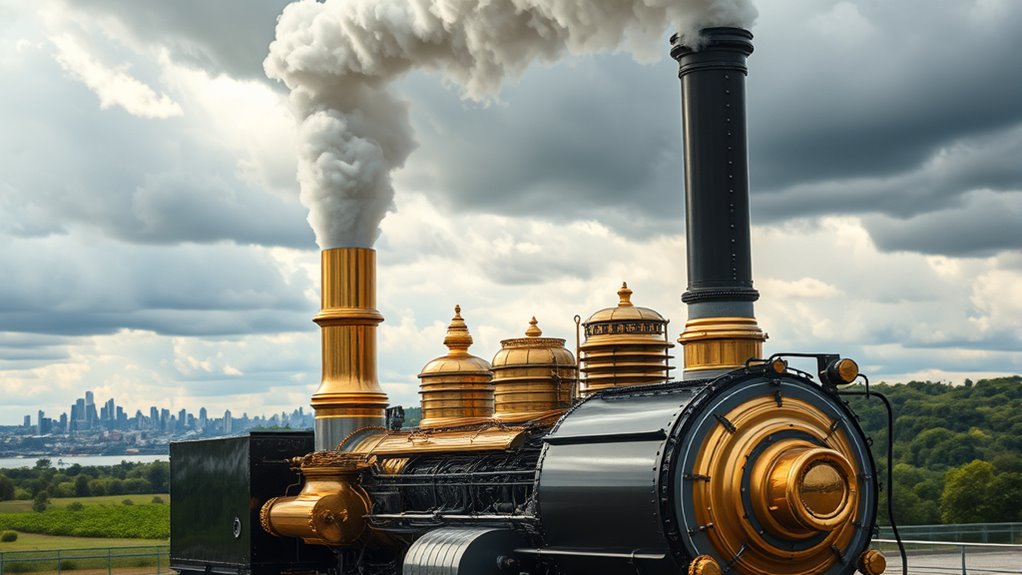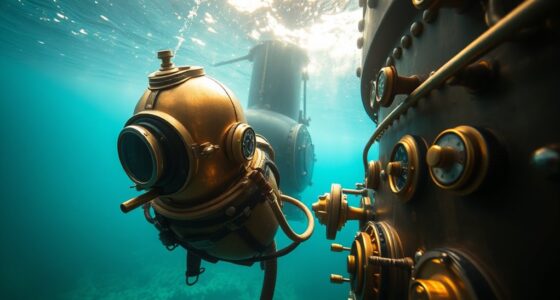Yes, modern steam engines are making a comeback driven by new technologies and a focus on sustainability. They’re being used in heritage railways, eco-tourism, and as proof of eco-friendly innovation. These engines now incorporate renewable energy sources and advanced materials to cut emissions and boost efficiency, blending historical preservation with modern safety standards. If you want to discover how these engines are shaping a greener future while honoring the past, keep exploring further.
Key Takeaways
- Modern steam engines are experiencing a revival driven by sustainable energy initiatives and technological innovations.
- They are increasingly used in heritage railways, eco-tourism, and educational demonstrations to showcase renewable energy solutions.
- New designs incorporate eco-friendly fuels like biomass, solar, and wind power, reducing emissions and carbon footprints.
- Integration of modern control systems with vintage designs enhances safety, efficiency, and relevance in contemporary contexts.
- The resurgence highlights the blend of historical preservation with eco-conscious engineering, proving they are making a notable comeback.

Modern steam engines, once the backbone of the Industrial Revolution, have experienced a surprising resurgence thanks to new technologies and sustainable energy initiatives. You might be surprised to learn that these engines are not just relics of the past but are now at the forefront of eco friendly innovations. As concerns about climate change and pollution grow, engineers and enthusiasts are turning to steam power as a cleaner alternative to fossil fuels. These efforts often blend modern engineering with a respect for history, making preservation of vintage designs both an aesthetic and educational priority. By integrating advanced materials and precision manufacturing, today’s steam engines operate more efficiently, emitting fewer pollutants, and showcasing how sustainable practices can coexist with historical preservation.
Modern steam engines combine vintage design with eco friendly innovations for a sustainable and educational revival
You’ll find that many of these modern engines are designed with eco friendly innovations in mind. They use renewable or less polluting energy sources, such as biomass or compressed air, that reduce their carbon footprint. Some are even powered by solar or wind energy, making them viable for eco-conscious applications like heritage railways or eco-tourism projects. This shift isn’t just about reducing emissions; it’s about demonstrating that historical machinery can adapt to contemporary environmental standards. These engines serve as tangible proof that sustainable energy solutions can be integrated into existing technologies, helping to bridge the gap between past and future. Additionally, the use of modern materials enhances durability and performance, ensuring these engines meet today’s environmental and safety standards.
When you explore the revival of steam engines, you’ll notice a strong emphasis on historical preservation. Enthusiasts and engineers work together to restore vintage engines, maintaining the craftsmanship and engineering techniques of their time. This preservation isn’t just about nostalgia; it’s about keeping alive a crucial part of industrial history, offering educational opportunities for new generations. Restoring and operating these engines allows people like you to witness firsthand how industries once thrived and how technology has evolved. Moreover, many of these restored engines are used in public demonstrations, festivals, and museums, making history accessible and engaging.
The integration of modern technology with historical preservation creates a unique niche where tradition meets innovation. You can see this in action when vintage steam engines are fitted with modern control systems or sensors, improving safety and efficiency without compromising their classic appearance. This balance highlights how historical preservation can be compatible with eco friendly innovations, ensuring that these engines remain relevant and sustainable. As the world shifts toward greener practices, the modern steam engine’s comeback is a demonstration of how respecting history can also lead to innovative, environmentally friendly solutions.
Frequently Asked Questions
How Efficient Are Modern Steam Engines Compared to Internal Combustion Engines?
You might wonder how modern steam engines compare to internal combustion engines in thermodynamic efficiency and fuel consumption. Generally, steam engines are less efficient because they lose more heat during operation. However, advancements in materials and design have improved their efficiency somewhat. While internal combustion engines still outperform steam engines in fuel consumption, steam engines now offer cleaner, sustainable options, especially when powered by renewable energy sources.
What Are the Environmental Impacts of Contemporary Steam Engine Technology?
You’ll find that contemporary steam engine technology has a smaller environmental footprint, especially when integrated with renewable energy sources. These engines produce fewer emissions and help with emissions reduction efforts compared to traditional fossil fuel-powered systems. By utilizing cleaner energy, modern steam engines can lower air pollution and carbon emissions, making them a more sustainable option. This shift supports global initiatives toward greener transportation and energy solutions, benefiting the environment overall.
Are Modern Steam Engines Cost-Effective for Industrial Applications?
Imagine you’re evaluating a new steam-powered factory line. You quickly see that a thorough cost analysis reveals higher initial investments but lower maintenance costs over time compared to diesel engines. Modern steam engines can be cost-effective if their efficiency improves and maintenance costs stay low. While not universally cheaper, their potential for long-term savings makes them an intriguing option for industrial applications, especially with technological advancements.
How Long Do Modern Steam Engines Typically Last Before Requiring Major Maintenance?
You might wonder how long modern steam engines last before needing major maintenance. Typically, their durability depends on build quality and usage, but you can expect maintenance intervals every 1,000 to 2,000 operating hours. With proper care, these engines can last several decades, making them quite durable. Regular inspections help you catch issues early, ensuring you maximize their lifespan and keep them running efficiently for years.
What Are the Main Technological Innovations Driving Modern Steam Engine Development?
You’ll find that the main technological innovations in modern steam engine development focus on enhancing efficiency and sustainability. Engineers incorporate historical accuracy in design, blending classic aesthetics with modern materials like advanced alloys and computer controls. These innovations improve performance, reduce emissions, and preserve the aesthetic appeal. By combining tradition with cutting-edge tech, you can see how modern steam engines maintain their charm while meeting contemporary environmental standards.
Conclusion
So, as you see, modern steam engines are quietly making a comeback, blending old-world charm with new-age engineering. Maybe someday, you’ll hop aboard a sleek, eco-friendly locomotive, feeling like a Victorian explorer but with a smartphone in hand. It’s almost as if the spirit of the Industrial Revolution is riding a Tesla coil into the future, proving that sometimes, history’s greatest innovations never really go out of style—they just wait for the right moment to roar back to life.








